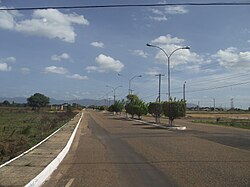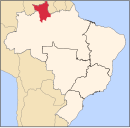Bonfim, Roraima
Bonfim | |
|---|---|
Municipality | |
| The Municipality of Bonfim | |
 | |
|
UTC−4 (AMT) | |
| Demonym | bonfinense |
| Website | bonfim.rr.gov.br |
Bonfim (Portuguese pronunciation: [bõˈfĩ]) is a municipality located in the mideast of the state of Roraima in Brazil. Its population is 12,557 and its area is 8,095 km2.[2] The city lies opposite the Takutu River from Lethem, Guyana. The Takutu River Bridge links Bonfim and Roraima with the town of Lethem and the Atlantic port of Georgetown, Guyana.[3]
Overview
In 1775, the Portuguese built Fort São Joaquim at the confluence of the Uraricoera and the Takutu River to prevent the Dutch from advancing into the area.[4] The ruins of the fort can still be seen.[5] In 1790, the Amerindians revolted, and the Portuguese retreated from the region.[4]
Bonfim started with the compound of a religious mission from the United States.[5] On 1 July 1982 it became a municipality[5] by Federal Bill Nº 7.009. On 28 March 2007 it was declared a free port for international trade by President Luiz Inácio Lula da Silva.[6]

The municipality is home to Amerindians of the Wapishana and Macushi tribes who live in the Wapixana, Macuxi, and Jabuti Indigenous Territories. Many of the indigenous community are tri-lingual speaking their own language, Portuguese and English.[5]
The economy is mainly based on livestock in particular
Transport
Bonfim is connected to the
References
- ^ IBGE 2020
- IBGE(in Portuguese). Retrieved 9 April 2021.
- ^ Stabroek News at [1] as of 16 March 2007
- ^ a b "Macuxi". Socio Ambiental. Retrieved 9 April 2021.
- ^ a b c d e "Historia da Cidade". Government of Bonfim (in Portuguese). Retrieved 9 April 2021.
- ^ "LEI Nº 11.732, DE 30 DE JUNHO DE 2008". Planalto.gov.br (in Portuguese). Retrieved 9 April 2021.
- ISSN 2070-1845.
External links
- Official site (in Portuguese)
 Media related to Bonfim (Roraima) at Wikimedia Commons
Media related to Bonfim (Roraima) at Wikimedia Commons

